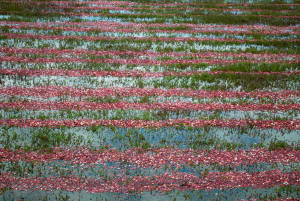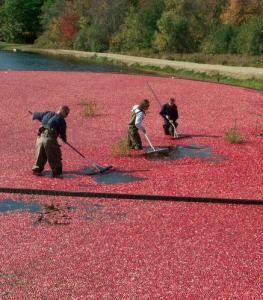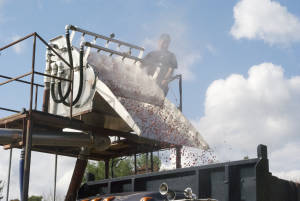
Cape Cod Cranberry Bogging, Our New Favorite Weekend Activity
Last year as Fall was giving way to Winter, I heard about an activity that seemed more unexpected than the typical “hay rides and pumpkin-picking” that Americans have come to associate with autumn. Mayflower Cranberries, a small family cranberry farm in Plympton, Massachusetts, was offering a “Be The Grower” harvest tour of their cranberry bog. Not far from Cape Cod, visitors would don galoshes and harvest cranberries from the flooded bog themselves– so needless to say, I had to try it.
They had me at “galoshes”.
I was excited to go on the tour with my parents, who are also into this kind of stuff– mostly because at the time I didn’t realize that cranberries were harvested in water.
Mayflower Cranberries has 23.5 acres of active cranberry bogs. They grow the Early Black variety, which is the first cranberry harvested each growing season (which starts in September), as well as Howes, Stevens, and Whiting-Randall varieties, which is what we were going to be seeing on the harvest tour. There are over 100 varieties of cranberry grown in North America, and Mayflower has put several of those heritage breeds on the map.
The day before each wet cranberry harvest, a bog is flooded using an industrial pump known as an “egg beater”. Because cranberries are filled with air pockets, they float in the water– flooding the bog is a way to gently knock the berries off their vines so that they can be harvested en masse from the surface.
Once the berries are off the vine and floating in the water, Mayflower and other wet harvesting cranberry bogs like it will use giant wooden or plastic buoys called “booms” to round up the berries (see our photo above). Then, the berries are essentially “vacuumed” up into a truck conveyor where they are washed and separated from the fragments of plants that may have come along for the ride. Those interested in “being the grower” are advised to enter the water in galoshes and to rake the berries toward the suction pump in order to expedite the process.
Because wet harvested cranberries will be saturated, they have a specific use: they are mulled to make juices, sauces, and sweetened dried cranberries such as Craisins. More than 90% of the cranberries in Massachusetts are wet harvested (a tune that amounts to about 14,000 acres out of the 47,000 acres of cranberries produced nation-wide).
The alternative to wet harvesting is dry harvesting— the process that yields the dry (but not dried) cranberries one finds in the produce section. For the dry harvest, farmers use walk-behind machines to rake the berries off the vines into a catchment whose contents are later screened for color and each berry’s ability to “bounce”. (Softer berries will not bounce, which is usually an indication of spoilage.)
On site at Mayflower Cranberries, my mother, father, and I watched this process in awe. Jeff LaFleur, shown sifting the berries atop the sprayer below, wasted no time in answering the crowds’ questions as he shifted a manual pump into the water and encouraged the visitors in galoshes to “rake” the berries towards the intake valve.
We were impressed with the berries’ resilience. “Don’t the plants get damaged or waterlogged?” someone asked of the flooded bog. No, LaFleur told us, revealing that an undamaged cranberry vine will survive indefinitely.
Some vines in Massachusetts are more than 150 years old– cranberries are one of only three fruits native to North American soil (the other two being the Concord Grape and blueberry)– and some of the vines at Mayflower Cranberry were planted over 120 years ago.
This resilience is all the more impressive given that cranberries can only grow under specific conditions: they require an acid-peat soil, an adequate fresh water supply, layers of sand, and enough “rest” during their dormancy period in winter to mature the fruit buds in what LaFleur’s informational site refers to as “an extended chilling period”.
On our way home from the bog– with fresh cranberries and several jars of cranberry jam in tow– I was thinking about the longevity of this distinctly North American fruit.
Cranberries are frequently associated with Thanksgiving and other autumn traditions with a specific culinary bent, but cranberries have been used for centuries by Native Americans, who harvested them for their medicinal properties. Pemmican, a popular Native American dish, was made from crushed cranberries, dried deer meat, and melted fat– but they also used cranberries, which are a natural antimicrobial, to treat arrow wounds and to dye clothing and other ceremonial materials.
Today, cranberries have undergone a renaissance after being named a modern “superfood”. We see cranberry extract added to floss and toothpaste as an anti-bacterial plaque fighter, and cranberries in one shape or form are often discussed as a natural remedy for bladder infections, stomach ulcer treatment, and blood sugar regulation.
Given the commonplace nature of the fruit, it was surprising how little I ended up knowing about how cranberries were harvested until we went on the tour. It was educational and fun, but mostly, it was beautiful— a mini tutorial on the role that cranberries continue to play in our past, present, and future.







































